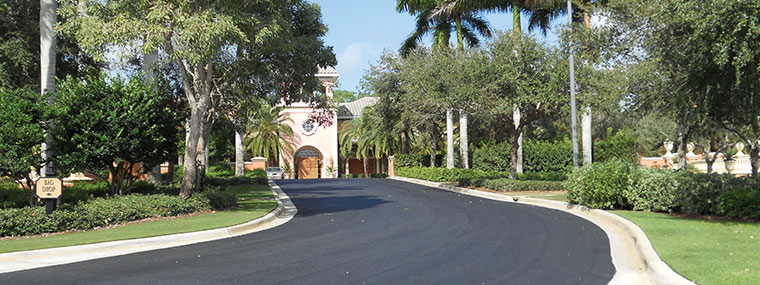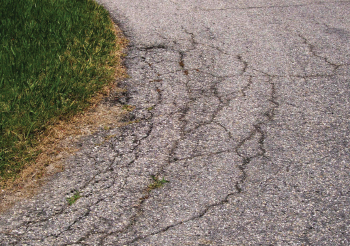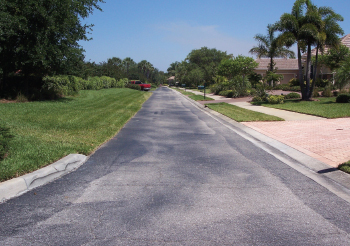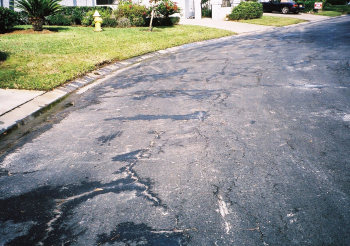
To Pave… or NOT to Pave?
by Connie Lorenz / Published April 2015

If I was given a dollar for every time that question was asked of me, I would be a very wealthy person. But, if I had to pay a dollar for every time I had to respond “I don’t know,” I would be broke. Why this is such a tough question to answer is not my lack of knowledge or experience, but rather, it is most likely due to the lack of direction of the clients, their budget, and what they are trying to accomplish.
 A good community will have typically set aside reserves for large projects such as an asphalt overlay. What to do next is where the confusion usually comes into play. Oftentimes, they will come to me and say that there are just too many different options being presented by the contractors. The contractors are using different application processes, recommending different products, and then using different terminology, all responding to the same bid request. The disparity in answers is often so confusing that the board becomes paralyzed into making no decision at all.
A good community will have typically set aside reserves for large projects such as an asphalt overlay. What to do next is where the confusion usually comes into play. Oftentimes, they will come to me and say that there are just too many different options being presented by the contractors. The contractors are using different application processes, recommending different products, and then using different terminology, all responding to the same bid request. The disparity in answers is often so confusing that the board becomes paralyzed into making no decision at all.
Because there are such an abundance of asphalt maintenance processes, products, and terminology, resulting in just about every type of solution, it’s no wonder communities are at a loss about what should be done. This is one of the main reasons why it is so important for a community to establish a written asphalt maintenance plan as soon as possible. Once in writing, along with establishing the proper budget for this plan, communities should find it much easier to find the proper direction to take.
 One of the most common mistakes I find is that communities do not budget the right amount for projects such as an asphalt overlay, because they base their budget on proposals they received years ago and then fail to update their quotes every couple of years. Asphalt is a petroleum product that is just as much affected by the rise in oil costs as is our gasoline. When you pay more at the pump, you can expect to see the price change in asphalt maintenance products soon after. Just like you cannot buy a house at the same price you did 20 years ago, you cannot put asphalt down at the same price either, so update the numbers in your plan at least every two to three years.
One of the most common mistakes I find is that communities do not budget the right amount for projects such as an asphalt overlay, because they base their budget on proposals they received years ago and then fail to update their quotes every couple of years. Asphalt is a petroleum product that is just as much affected by the rise in oil costs as is our gasoline. When you pay more at the pump, you can expect to see the price change in asphalt maintenance products soon after. Just like you cannot buy a house at the same price you did 20 years ago, you cannot put asphalt down at the same price either, so update the numbers in your plan at least every two to three years.
The best asphalt maintenance plan is one that gives you the most life with your current asphalt cap. Understanding asphalt and why it deteriorates is probably the best place to start. Your parking lots and roadways or pavement are a mixture of about 94 percent aggregate with the remaining percentage the asphalt or binder. This asphalt binder is the glue that holds your aggregate together and most importantly is the maltenes. The maltenes are the only portion of the pavement that is subjected to degradation due to oxidation. Oxidation is the natural breakdown of your asphalt cap due to the elements that surround it, such as traffic, irrigation, fluid spills, and, of course, our constantly changing weather patterns. It doesn’t matter where you live, the value of your homes, or the dues you pay for your homeowners association, asphalt is asphalt, and it’s all going to break down!
 These elements cause these binders in your pavement to evaporate or shrink, thus causing your pavement to fade, crack, and age. Most asphalt in Florida has an average lifespan of 15 years, however some communities’ maintenance programs have their asphalt lasting 25 years or more in areas that might not even see 10 years (here comes a special assessment …Ouch!). With the right maintenance program, you can possibly double the life of your pavement if not triple it; however, with the wrong maintenance program, you can actually reduce its life expectancy.
These elements cause these binders in your pavement to evaporate or shrink, thus causing your pavement to fade, crack, and age. Most asphalt in Florida has an average lifespan of 15 years, however some communities’ maintenance programs have their asphalt lasting 25 years or more in areas that might not even see 10 years (here comes a special assessment …Ouch!). With the right maintenance program, you can possibly double the life of your pavement if not triple it; however, with the wrong maintenance program, you can actually reduce its life expectancy.
Additionally, this timeline can be altered by other issues that are different for each property. For example, a property that has a soil-cement base rather than a limerock base will have noticeably different forms of deterioration than its counterpart. If a community does not have concrete curbing or guttering in place, this community will have far more edge deterioration than a property that has them. If a community is gated and only allows their residents to travel on their roads, they will deteriorate more slowly than a community that is not gated. All of these factors are important when trying to establish a budget and maintenance plan and are often overlooked, resulting in the community falling short with their budget or the expected life of their roadways.
Educating yourself about what surrounds your roadways, the type of base installed on the property, any previous issues, as well as past asphalt maintenance programs will help put your community on the right track. I constantly see communities replace their asphalt either prematurely or worse, pay an outrageous amount for an overlay and then begin the same asphalt maintenance that forced them to have to do the overlay to begin with.
So now you decide to take the first step and create an asphalt maintenance plan, the big question that you face is, “what should go in it?” Pavement is designed to be flexible in order to expand and contract in accordance with our daily temperature changes. When the surface oils begin to oxidize, your pavement dries out and loses the ductility it needs to make these daily adjustments and begins to crack and ravel in order to relieve the stress placed on it. Without proper maintenance, these cracks break through to your sub-base and begin to allow water to penetrate into your asphalt cap, thus causing unseen damage that seems to appear overnight. Damage beneath the asphalt cap is far greater than what can be seen on the surface.
Preventing damage from oxidation is the best way to maintain your asphalt; however, most communities tend to wait until the damage is already done before they begin an asphalt maintenance program. The best way to maintain untreated asphalt is to keep your pavement conditioned and pliable by investing in an asphalt rejuvenation program. This is a process that is made up of the same products as your asphalt and once applied, penetrates the asphalt cap and replenishes the oils that havebeen lost due to oxidation. Asphalt rejuvenators are only offered by a few contractors in Florida and some of those that do offer them are not true rejuvenators and are only playing on the word in hopes of getting the sale.
Researching the different processes offered is the best way to eliminate the possibility of paying a premium dollar for a not so premium product. Understanding the differences between the surface treatments on the market and understanding that just because they turn the pavement black doesn’t necessarily mean that they are providing the same processes. I recently found out that a contractor in south Florida was showing his potential clients one of the projects my company treated, misleading his clients into thinking they were going to get the same process. Luckily, I was called in as a potential contractor to bid the project and when the client noticed the same references in the area, it was brought to our attention. Luckily, we were able to provide the backup documentation to prove we completed the work, and the other contractor was removed from the bid process. Unfortu-nately, there were other communities that weren’t so lucky!
Some properties have invested in a maintenance program using a water-based coal tar or asphalt emulsion also known as sealcoat. Sealcoating was the first surface treatment designed on the market some 70 years ago. Sealcoating is applied to the surface of your pavement and is designed to temporarily block the damage of oxidation while in place and is known as a sacrificial surface. The downfall of this product is that because it’s water based and your asphalt cap is oil based, a natural barrier occurs between the two surfaces that prevents the sealcoat from staying in place and protecting the asphalt surface. Communities soon find their property aesthetically unappealing as their drive lanes and turn lanes begin to delaminate or peel up, and the edges of their roadways and parking areas remain coated.
Unfortunately, another thing they begin to notice is that where the sealcoating does remain, fine cracks develop in their asphalt surface. This is because asphalt and sealcoating expand and contract at different temperatures. In an attempt to make their community more aesthetic, they apply more sealcoating and soon discover that the cracks become larger and larger with each application until eventually a complete overlay is needed. It’s quite the vicious cycle, and this type of process usually ends up costing communities thousands of maintenance dollars as well as reducing the life of their pavement. The good news is new products are available in the market, and corrections and modifications have been made to old formulas to reduce these types of issues.
Another issue I come across on a regular basis is that when residents or board members relocate from up north, they tend to think the maintenance program they used back home should work here. How wrong they are! Up north, most roadways and parking lots are constructed with six to eight inches of asphalt because of the freeze/thaw cycle that the northern regions are exposed to. Here in Florida, we are lucky to see two inches of asphalt on a new development.
We don’t get snow, sleet, salt trucks, or any of the other issues that surround these northern areas. Nope, Florida is quite unique in this aspect compared to any other state in the country.
Connie Lorenz, President
Asphalt Restoration Technology Systems, Inc.
Asphalt Restoration Technology Systems, Inc. (AR Tech) has been established in Florida since 1993. Connie Lorenz is President of AR Tech and has been with the company since 1999. Her leadership skills and classes have taught thousands of consumers about proper asphalt maintenance and has helped save them thousands of dollars, and she has become an advocate in the industry focusing on protecting homeowners, property managers, and owners from the downfalls of questionable contractors and improper techniques. For more information, visit www.asphaltnews.com.
In summary, it is most cost effective to take care of your current asphalt cap the way asphalt needs to be maintained. As an analogy to help communities understand, I ask them if they wanted to preserve a beautiful wood home would they paint (sealcoat) the structure or stain it. By painting it, over time, they would notice that the paint would begin to crack and chip and would require far more maintenance and money to maintain. However, if they stained (rejuvenated) it, the stain would soak in and condition the wood and keep it from drying out and cracking thus reducing their maintenance cost overall. Please be careful when investigating rejuvenators as there are many products that play on the word rejuvenator meaning to enhance or improve the appearance of the property and not necessarily condition or rejuvenate the binders in your pavement.
Once the asphalt maintenance plan has been established, it is important to have your asphalt reviewed on a frequent basis (every year or so), to ensure that new issues have not come to the forefront. Please remember, just because it looks like something that needs to be corrected, does not mean that it necessarily does. One common mistake communities make (usually at the behest of a paving company) is the interpretation of symmetrical cracking. If your community has a soil-cement base, also known as a floating base, and they are trying to get rid of the symmetrical cracking on the property, give it up! You will soon find within a year or two of a new overlay that the exact same cracking, which you just covered up, will return in the exact same pattern that was there before. This is known as reflective cracking or mirroring and is unavoidable when working with a soil-cement base.
However, if they invested in milling out or removing the original asphalt cap to the base or invested in a crackfill program prior to the install of the new asphalt cap, they would find that these aesthetically, unappealing cracks could have been delayed substantially. These two factors, milling and crackfill, are typically the first things communities eliminate and contractors deduct in order to meet the financial boundaries of a community’s budget.
Unfortunately, eliminating this added cost during an overlay is typically the reason for premature failure in their new asphalt cap. I like to tell communities that you can pay a little bit more now or pay a lot more later on.
If you have been reviewing your asphalt annually, you should have a good idea of when you must actually pave. Once the decision is made, an important concern that has recently become more prevalent is contractors coming in from other states during our winter season and offering discounted prices in hopes of finding work during their off season. They travel the state and will put down whatever and whenever the opportunity arises…even if you weren’t looking for anything at that time. In some cases, we have seen the board overlook the normal qualifications of a contractor and end up paying double the cost later on. Research your contractors and look for those that have been around awhile. It is very common for contractors to change names every few years in order to avoid warranty issues, so please do your homework.
So, if you must overlay, you should first make sure you use a licensed and insured company from Florida to start with. Make sure to ask if the contractor is going to actually do the work or if they are going to hire a sub-contractor to do it. This is often overlooked and can result in problems should defects arise or payment not be made to the right people. Second, get three quotes and make sure all the proposals include the same thing. If one quote has milling, another offers crackfill, and the third just a one-inch overlay, you will see a huge difference in price. As
a community, you tell the contractor exactly what you want, and if they fall short of your expectations, ask them to re-quote the project in the same format as the other bids. Finally, and most importantly, once your new asphalt is in place, invest in the right method to maintain your pavement for your surroundings.
Roadways and parking lotsare one of the highest expensesfacing a community and making them work for you by in-vesting in them would be far more beneficial than choosing a program that becomes an ongoing expense that drains your budget. Educate your community, establish a maintenance plan, and then initiate a program, and you will soon see your maintenance budget working for you.


